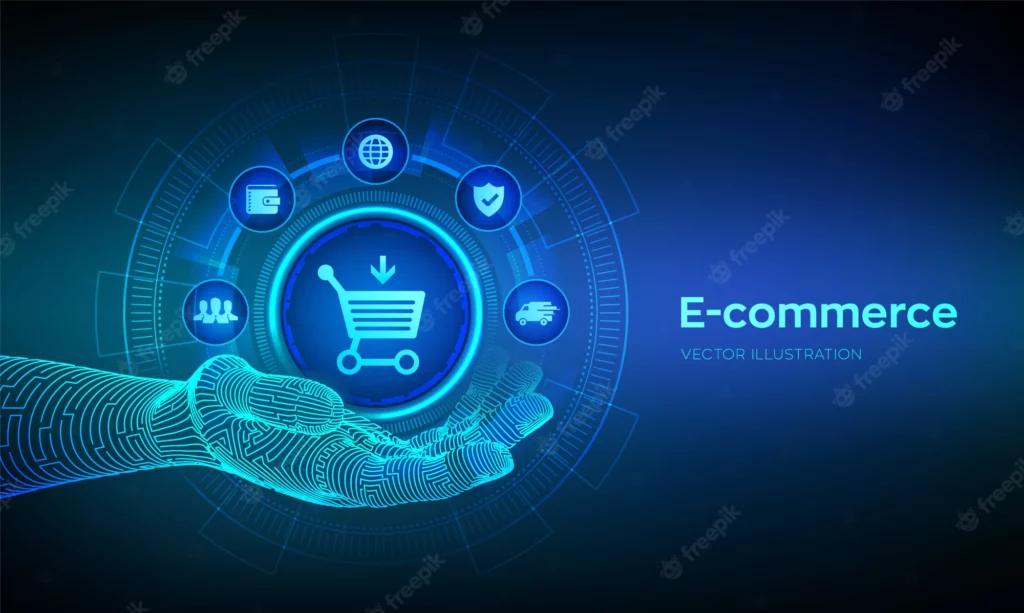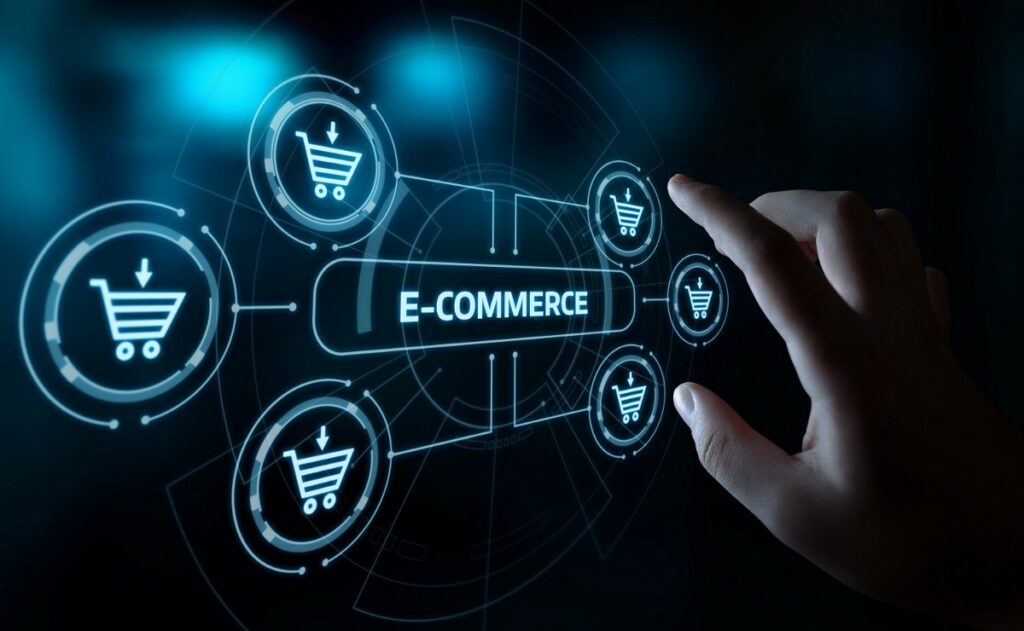E-Commerce

Because of the widespread adoption of the Internet for business processes, differentiating between the numerous forms of digital marketing practiced today can be challenging. Take e-commerce marketing as an example; what exactly is it, and how does it stack up against other forms of online advertising like social media, content, search engine, and email marketing?
Digital marketing does not have to be separate from e-commerce marketing. All of the aforementioned digital channels are available to e-commerce websites and can be used to increase sales and promote brand awareness.
This overview of e-commerce advertising will look at every type of digital platform now in use.
For those unfamiliar, please define “eCommerce marketing.”
Marketing for an online store is the process of increasing exposure to and interest in that store’s offerings. Marketers in the e-commerce space can leverage social media, digital content, search engines, and email marketing to draw in customers and expedite online transactions. Let’s have a look at the definition of eCommerce advertising and the equality of advertising and marketing for an eCommerce firm before we go deeper into what eCommerce marketing is and how to apply your strategy
Commercials for Online Store
In the same way that traditional advertising falls under the broader category of marketing, eCommerce advertising is a subset of eCommerce marketing that allows you to reach your target audience more and, in turn, increase sales and brand recognition. E-commerce marketing, as we’ve established, is all about getting people to learn about and buy your wares. While the strategies you use to promote your goods are what we call “eCommerce advertising,” they are essential to the success of your online store. These advertisements might be display ads, banner ads, or rich media ads, and they are typically used for online or eCommerce marketing and sales.
The most important thing to remember is that while planning your eCommerce marketing strategy, eCommerce advertising is a powerful tool to use to promote your product.
Let’s get back to the meat of our e-commerce marketing conversation.
Varieties of Online Store Promotion
Here are some common marketing channels and how you’d use them to construct an online store to give you an idea of what an eCommerce marketing plan looks like.
Advertising in Social Media
Popular social media platforms now host pages for brands, publishers, contractors, and expanding enterprises to engage with their target demographic and share relevant information. You can do the same if you’re an eCommerce marketer, however, your campaigns will likely look different, and not every social media platform will be a suitable fit.
E-commerce sites are inherently visual since you have to show off the goods, so it stands to reason that if you want to succeed in drawing visitors to your product pages, you need to employ compelling visual content to do so.
Instagram is a great option for online retailers since it lets you showcase high-quality product photos and reach a wider audience than your typical shopping cart would.
Adding “shoppable” material to your social media posts is a great strategy to increase conversions and expand your reach. These can range from display adverts embedded in a social feed to additional tags that trigger in-feed purchases. The use of these strategies will help you streamline the purchasing procedure. Even for an online retailer, feedback on products is nothing new. If your company currently encourages customers to leave reviews across your online store, then a Facebook Business Page is the perfect place for you to express their positive feedback. Down below, we’ll have a more in-depth look at several product review formats.
Using Content to Market Your Product
Content marketing, which includes blogging and video marketing, refers to the practice of creating and distributing online articles, videos, infographics, and other forms of media to increase traffic to your site and establish it as an authoritative resource in its field. But if you’re trying to sell something online, is it necessary to have content like articles and videos to attract customers? Yes, you do.
Your product page copy might use some tweaking.
The product name itself should be one of the short, product-driven keywords you optimize your product pages for. If you sell bridal gowns, for instance, including the term “brown bridesmaid dress” on the page increases the likelihood that a Google search for “brown bridesmaid dress” would return results like yours.
To increase the chances of search engines returning your online shop in response to a particular inquiry, you should also include relevant keywords in the titles, headers, and alt text of your web pages.
Create blog entries that are timely and informative.
Writing blog entries about “how to plan a wedding” can bring in customers for an online bridal shop at every stage of the planning process. With the help of blogs like “how to select the appropriate wedding dress” and “downloadable wedding planning checklist,” you may convert interested visitors into leads.
Publish guest articles on other people’s websites.
You should look for sites that rank for keywords related to your product. If a site already has a relatable post, offer to expand on it by providing additional cta and links to your eCommerce site. This will get you in front of relevant audiences (often for free).
Upload instructional videos on the product to the video-sharing website YouTube.
Use highly searched keyword terms to determine your topics, then share videos that are related to your product and helpful to your audience. This is also a great option for tutorial videos that show current customers how to use your product. YouTube has over a billion active users, so chances are good that your target audience is somewhere in there.
Have a frequently asked questions (FAQ) section that is based on keywords.
Create a Frequently Asked Questions (FAQ) page on your website with answers to high-volume, long-tail keyword searches to get users to your site, and you’ll be building authority and traffic, two crucial components of a successful eCommerce store if your audience is asking questions related to your product.
Online Marketing Through Search Engines
Paid advertising, such as pay-per-click (PPC) campaigns, display campaigns, or product-specific ad campaigns (think Google Shopping), can help you achieve higher rankings in search engine results pages (SERPs) than organic SEO alone does.
Pay-per-click (PPC) ads on Google ensure that potential customers will see a link to your page when they enter search phrases that match the terms of your campaign, but the payout to you should be substantial because you pay Google each time a person clicks on your result.
E-commerce marketers know this, so they sign up for Google AdWords and run pay-per-click (PPC) ads to promote product pages. When a user clicks on a paid result, they are taken directly to the product page, boosting the possibility that they will make a purchase.
Direct Marketing via Email

The age-old practice of email marketing has, surprisingly, proven useful in the modern field of eCommerce promotion.
The best aspect of email marketing is that it can be automated. With automation, you can set up a successful drip campaign for subscribers who are categorized by interest or stage in the buyer’s journey and let your email campaign do its magic.
However, it is critical to be thorough when compiling your email list to ensure continued confidence from your leads. In this day and age, where users’ concerns over their personal information are at an all-time high, not every commercial email is welcome in the inbox.
Here are two examples of how an online store could employ email marketing.
Communication After the Sale
Sending a follow-up email to a customer a few days after the delivery of an item they purchased from your website (and whom they consented to receive emails from throughout the purchase process) is a great way to keep the conversation continuing and measure the customer’s future interest in your product line.
In addition to demonstrating that your organization is invested in more than just making a sale, a follow-up after a consumer has made a purchase demonstrates that you genuinely care about their experience with the transaction and can help you improve the purchasing process for future customers.
Asking for feedback in the form of a review or access to exclusive content on how to make use of the product are two excellent uses of this medium of communication (those YouTube videos you created would be perfect here).
The Unattended Shopping Cart
In this post, we’ll go through the many causes of shopping cart abandonment and the emails you can send to your customers to help them finish their purchases.
If a customer abandons their online purchase while in the shopping cart, you can win them back over by sending a kind email reminding them to finish up, offering help, or suggesting complementary items.
Marketing with Influencers
It’s popular to use the term “influencer” to refer to Instagram accounts with tens of thousands of followers, but the phrase may also refer to a celebrity or community that your target market follows or belongs to.
To promote your online product, influencers will need to endorse it to their followers, which they may do through a “sponsored post” because they have already established a rapport with their audience.
Market Affiliate
Affiliates are persons or businesses that help sell your goods online in exchange for a commission, and 81% of brands use affiliate marketing.
Affiliates are like having a team advertise for you since, unlike most social media influencers, they generate interest in things through traditional (but effective) marketing methods such as paid advertising, content marketing, and so on.
Regional Advertising
Local marketing is a strategy that is often overlooked by e-commerce businesses, but it can help you focus on the areas where most of your prospects are (if there is a high concentration of them in one place) and offer incentives to your potential customer base.
Tips for Marketing Online Stores
Create a mobile-friendly layout for your website.
Besides the tried-and-true approaches we just covered, there is a wide variety of other eCommerce marketing strategies you may use to attract customers to your online shop.
Incorporate customization first.
What is it about personalization that helps businesses raise their income by 6-10%?
When you personalize your marketing, you identify ways to meet the specific demands of your target audience by modifying existing content.
Smart content can be displayed on a webpage when a user returns for a second visit or has progressed further along the buyer’s journey, for example by using the prospect’s name in the subject line of an email or making product recommendations based on previous browsing history.
With personalization, customers don’t have to waste time looking for the information they need; it’s already there, in front of their eyes. This makes it far more likely that they’ll take the next step in the buying process, which is to make a purchase.
Second, make use of material created by your audience (UGC).

What if your consumers could promote your brand for free? That’s the idea behind user-generated content (UGC), which involves giving your customers a platform to do just that.
This is useful because (1) it increases visits to your online shop, and (2) it helps you attract and retain customers who are truly interested in what you have to offer.
For their “Share a Coke” campaign, Coca-Cola® did an excellent job at this by having individual bottles of Coke® emblazoned with people’s names; these bottles were then organically shared throughout various social networking sites.
To encourage user-generated content, try these methods.
Consumers can participate in contests where their product is on display to win a prize.
Sites where people can write reviews regarding their experiences with your goods
Hashtags on social media, where people share content using a designated hashtag, are becoming increasingly popular.
Create a customer loyalty plan.
Building a client loyalty program requires some thought and labor, but it pays off in repeat business, user-generated content, recommendations, and retention.
As an e-commerce company, you should give some thought to how you will reward your customers’ loyalty. This could be in the form of points, discount codes, or exclusive perks, and it should also take into account the various ways in which customers can demonstrate their loyalty, such as through repeat purchases, social media mentions, or the sharing of your content.
Initiate Marketing Through Word of Mouth (WOMM)
The need for word-of-mouth marketing in your business becomes more obvious as consumers become warier in marketing strategies from corporations. This type of marketing is founded on the idea that people value the opinions of those who are similar to themselves.
This can happen naturally if you provide a fantastic experience for your customers, but you can also actively encourage and even develop types of WOMM that are just as successful.
Create a mobile-friendly layout for your website.
All facets of your e-commerce strategy, no matter how small, should incorporate a mobile-friendly layout. All of your e-commerce advertising strategies will be accessible and simple to use on any mobile device (e.g. laptop, smartphone, iPad, or tablet).
This means that your content will be legible and straightforward regardless of the device or location used to access it, which is very important in today’s mobile-centric society. For some instances of good responsive web design, see this post.
Marketing Approach for Online Stores
Let’s put everything together and go over some pointers for creating a successful marketing plan for your online store now that you know the ins and outs of eCommerce marketing.
Targets should be established in light of typical performance in the sector.
You can use industry benchmarks as a standard against which to evaluate how well you are doing in terms of several metrics, including as revenue growth, employee retention, and customer satisfaction. Think about metrics like site traffic, CTR, and CAC, and see how they stack up against similar e-commerce businesses.
The key is to chunk your strategy into manageable pieces.
Numerous options exist when developing a strategy for promoting your online store’s products and services, and we’ve already covered many of them. It’s tempting to try your hand at them all, but doing so guarantees failure for everyone. We advise that you zero in on a few key ideas that you think will have the highest return on investment (ROI) and that is also within your reach, and then develop concrete next steps for each. Let’s imagine, for the sake of argument, that you’ve settled on the idea of using a paid campaign to attract customers to your shop. Create a Google Ads account, decide how much you’re willing to spend on ads, compile a list of keywords that you want to rank for, and then monitor your account every day. In case this seems overly simplistic, that’s because it is. Avoid becoming sidetracked by the promise of the next “amazing e-commerce strategy” at the expense of putting an existing one to good use.
Make your new and returning clients happy.
After a purchase has been made, marketing continues. Once someone has become a customer, they should be actively involved, nurtured, and delighted. You’ll earn your clients’ loyalty by investing in their future success. It will encourage your clients to spread the word about their excellent experiences with your business to potential leads and consumers through case studies, reviews, testimonials, and word of mouth.
